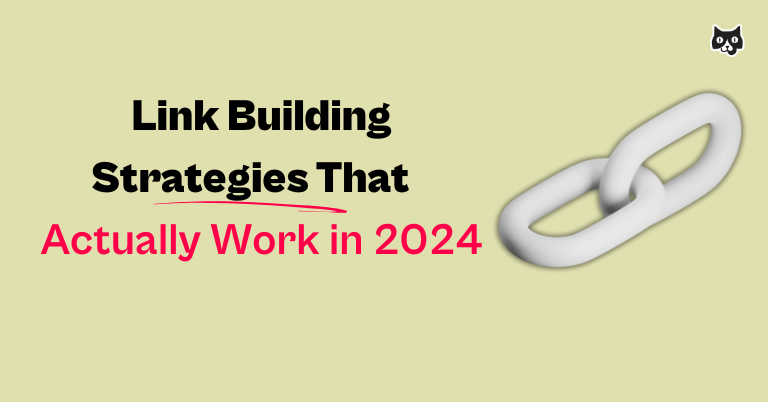Ever read a blog about link building strategies, tried the strategies, only to get:
- No responses, or
- Responses asking you to pay for links?
It gets so bad that most people doing SEO have declared link building as an impossible feat.
Why is link building the most pain-inducing part of SEO?
Mainly, because it’s hard to do it at scale, since it requires something that isn’t scalable: building relationships.
Building backlinks isn’t the funnest part about SEO.
But, it’s a cornerstone to SEO best practices. Luckily, it’s not as impossible to do as you think.
Not all of us have long lists of industry-wide connections to boost our content straight off the bat. But you can and should build them. In fact, they’ll be the cornerstone to scaling backlinks.
Instead of regurgitating the top techniques you’ve probably already read 100 times, we decided to ask people running successful websites what techniques have actually worked for them.
Using these (white-hat) methods, our expert SEOs and our own strategists at our B2B SaaS SEO agency have built thousands of high-quality backlinks, directly contributing to growing a high-impact inbound channel.
In this post, we’re going to go over 10 of the most successful strategies for link building from professional marketers. Link building strategies you’ll actually be able to use.
What is a link building strategy?
A link building strategy is the process by which webmasters collect references from other websites that links back to their own content. A strong profile of backlinks-links from other websites back to one’s own content–is one of Google’s most important ranking signals.
The more people link to your website, the more social proof it is that your website is relevant. While you can organically get backlinks from publishing strong content, you can also use strategies to build them intentionally.
Related Post: B2B SEO: 8-step Holistic Strategy You Wish You Started Yesterday.
Strategies for link building
Here’s a list of 10 strategies that others have tried and tested—and that have actually worked.
1. Create linkable assets
Natural links are favored by Google and users alike. They’re more relevant, they’re clearly not bought, and often they’ll even drive referral traffic to your website.
Curate industry statistics
Creating a hub of the most relevant statistics in your industry works wonders for building quality backlinks.
Content creators look for stats all the time. They like building data-driven content, and they need data to back it. If you can curate the stats on one page, it helps content creators cut back on research time.
You don’t need to own the data. Even when citing your secondary sources, having a curated list of industry statistics that are clear and to the point does the job. These posts act as resource pages for both searchers and content creators.
Steven Macdonald, Founder of Kingspoint, says that by using this link building tactic, he’s been able to “land links from TechCrunch, Intercom, Forbes, Shopify and Mailchimp. I rank number one for all “Industry” statistics posts I’ve published. I’ve earned 6,000+ backlinks over the course of 3-4 years using this tactic (to the stats blog posts)”
“Guest blogging still works great for us. The catch to using it in 2024 to significantly increase the quality of work. So if you put yourself in the ‘shoes’ of the receiver, you will understand that templatized outreach is not effective. Even if you get a positive answer it will be from a low-quality website. This is why the key is to use personalized email outreach.”
-Davor Bomeštar, CEO at Fortis Agency
Create original research
Evelina Milenova, SEO Manager at Opinion Stage, has seen success in this strategy. She says:
“The biggest pro of this strategy is that it’s easy to get links to original research that’s curious and adds value to the reader. The main con, though, is that original research is not always easy to craft – you need an idea and the resources to execute it. For SaaS brands with access to unique data, that’s somewhat easier. However, even smaller companies can leverage this strategy by syndicating information from other studies or using affordable tools. I’ve worked on a couple of linkable assets we created with Google Trends (a free tool), and they got over 50 links naturally.”
2. Triangle backlink exchange strategy
The triangle backlink exchange strategy is a win-win three-way link relationship.
Foti Panagiotakopoulos, Founder of GrowthMentor, got backlinks from 154 dofollow referring domains with an average Domain Rating of 65.7 in around 6 months using just this strategy. He says “for this strategy to work, you’ll need to have access to another website that’s got a DR60+. Essentially it’s a turbocharged backlink exchange where you say ‘Hey! I’ll get you a backlink on this DR60+ website if you can give me a backlink to my other site (the target).’”
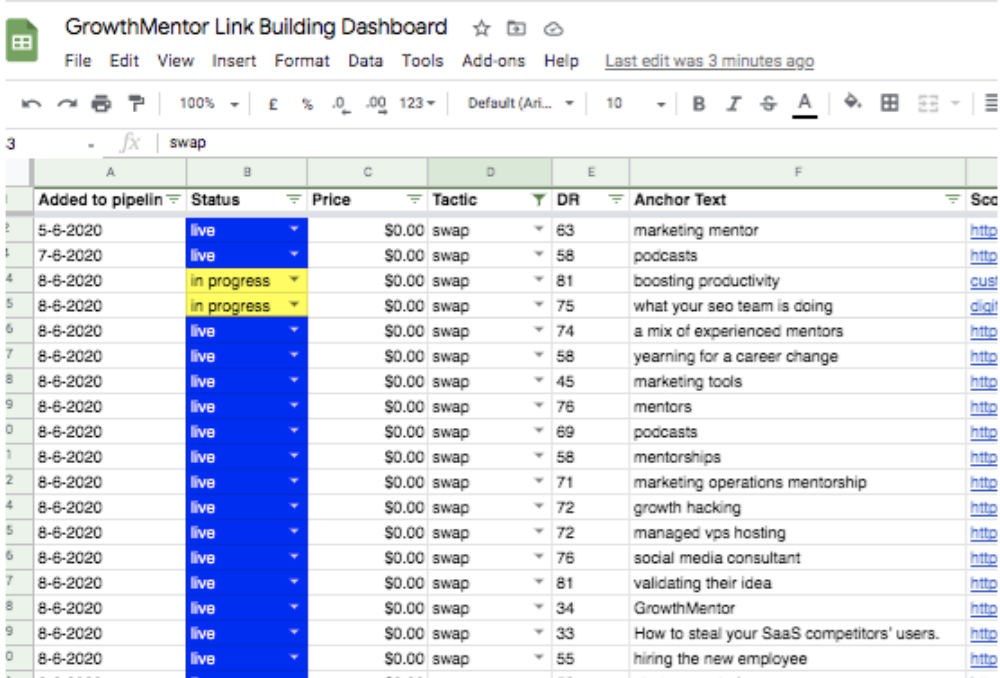
Foti’s spreadsheet keeping track of link swaps in the triangle strategy
Foti says that “What makes this special is that the exchange is non-bi-directional, which makes it much easier to get a ‘yes’ on an outreach attempt”. He also says “My #1 tip for building links the white hat way is just make more friends.”
3. Enhance your Digital PR through writer forums
Marissa Sabrina, Creative Director at LeadLearnLeap suggests creating accounts on writer forums. She says these tools connect experts with journalists, bloggers, or content creators seeking insights on specific topics. Her team actively engages with these platforms by answering questions related to their expertise, consistently providing valuable insights and expertise to increase the chances of being featured in expert roundups. This involves sharing your knowledge, opinions, and experiences on relevant industry topics, contributing to the overall content landscape.
SEO Consultant, Phillip Stemann, recommends signing up with your credentials and your area of expertise in your profile. He advises against using AI to answer these questions.
Alan Redondo, Founder & CEO of Ardoz Digital says, “It’s one of the most dependable, credible, and affordable (it’s free) ways to get natural backlinks. I personally dedicate an hour or two every weekday to answer some queries. Basically, I filter queries that I’m qualified to answer, take some time to craft some valuable insights, then submit it and monitor for any mentions or backlinks gained from the platform.”
Phillip recommends signing up to popular writer request forums like:
- Connectively (Formerly known as HARO, now transitioning to a freemium model)
- Featured
- Help a B2B Writer
- Qwoted

A screenshot of Help A B2B Writer
Phillip has built 30+ links from websites with a DA anywhere between 30-80. It’s incredibly powerful, and it’s helped him rank easier for newer terms when he writes content. Alan has built more than 100 high-quality backlinks, all gained without burning his wallet. Redondo had a 15-20% success rate just within the HARO platform alone, which boosted the DR and organic traffic for both him and his clients.
BONUS TIP from Alan Redondo: If you have the budget for a PR Manager, work with them to craft high-quality answers from your first-hand insights.
4. Use testimonials to secure backlinks
Hamza Hanif from Postman SMTP says his strategy for success has been writing positive testimonials. The goal is to get high-quality links, not spammy or PBN links. Hanif writes positive testimonials for a product or service that he’s used and asks the owner of the service if they can feature it on their website with a link back to his site.
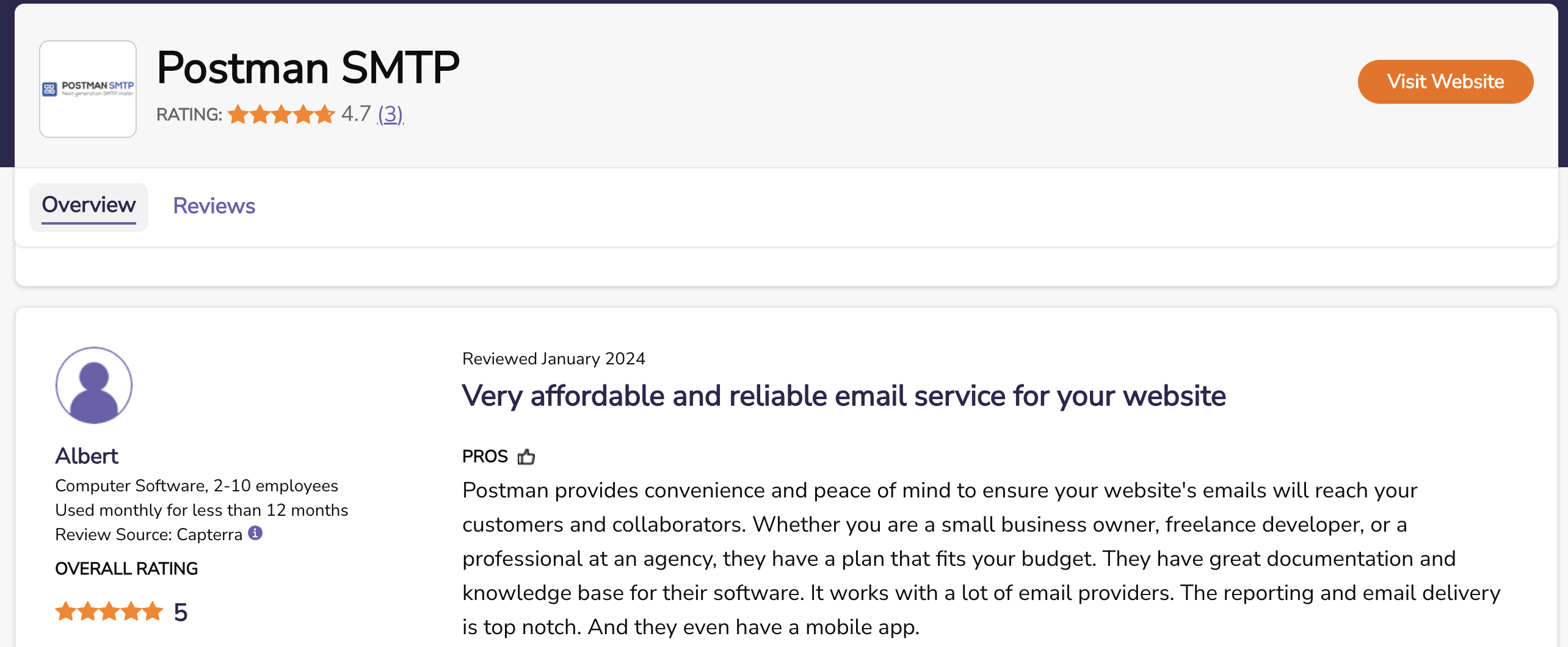
Write positive testimonials on a website to request a backlink from the company
5. Broken link building strategy
LinkPitch’s Founder, Aaron Anderson says that broken link building works by finding pages that are no longer serving their original purpose (most commonly 404 errors). And then, notifying sites currently linking to the broken links to let them know about the broken link, suggesting a resource of yours as a replacement for it. The idea is that when you’re pointing out an error, sites are usually more open to adding a link in return than if you were to simply offer a resource.
Antonio Gabric, Outreach Manager at Hunter.io explains his process around this:
1. Log onto Ahrefs and type the domain name of the company you would like to receive a backlink from into the search bar.

Screenshot of Ahrefs search toolbar
2.On the left menu, scroll down to “Outgoing Links” and click on “Broken Links”.
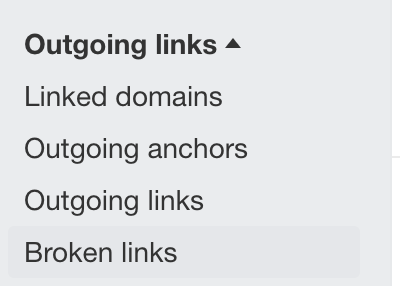
Screenshot of Ahrefs left menu feature to find broken links
3. Bonus step by Aaron Anderson: If you come across a page with several external links, use a Chrome extension called Free Backlink Checker by LRT. It highlights broken links and other errors. It’s best to inspect links manually, some tools don’t catch all of them. Keep an eye out for things like redirects and parked domains too.
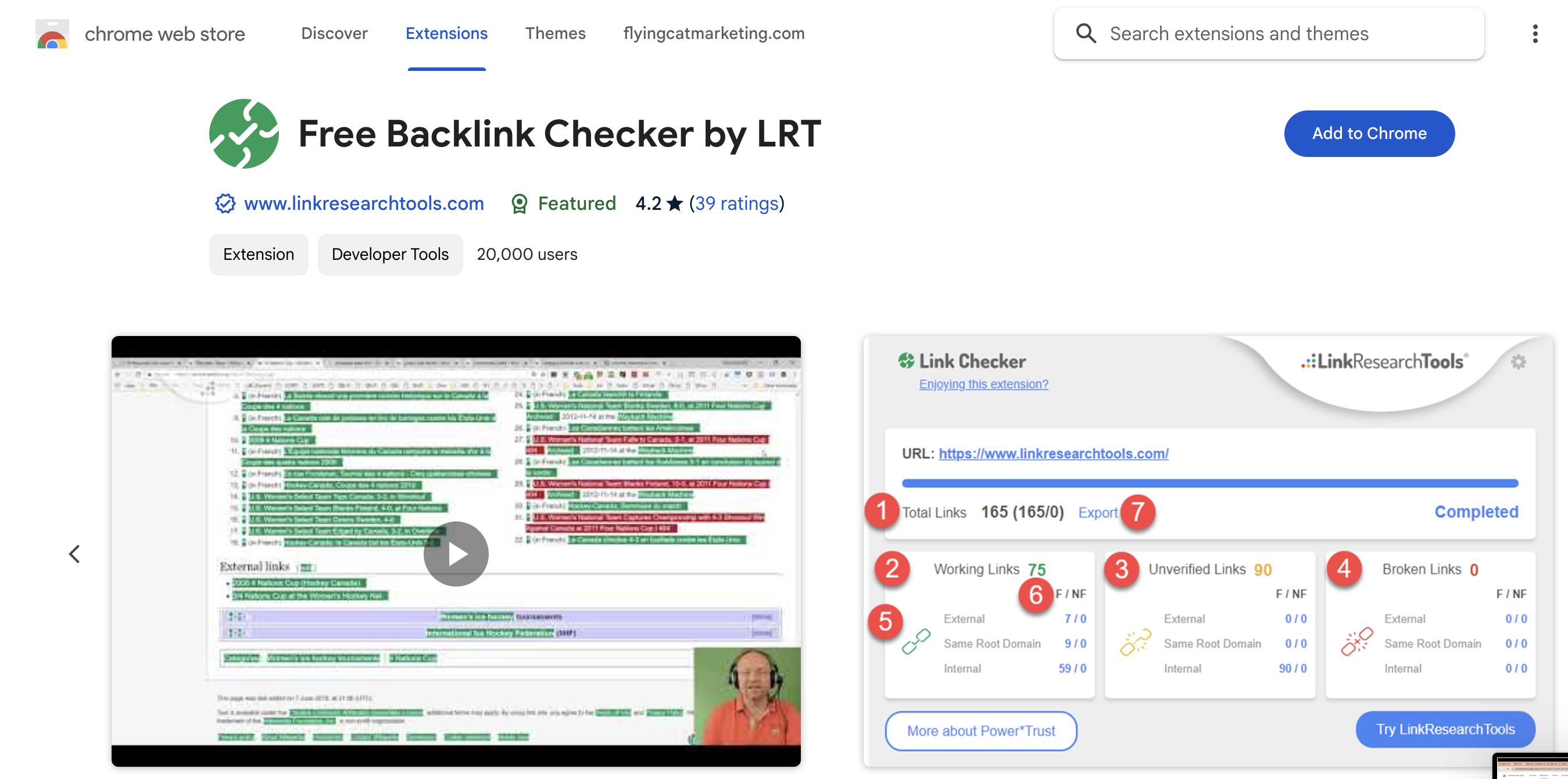
Use a free backlink checker through Google Chrome to detect external broken links
4. Finally, run a report telling you where the broken links are on their website.

Screenshot of an Ahrefs broken link report Source: Ahrefs
Gabric reports receiving around 20 backlinks in 10 days with this tactic, all from websites averaging 67 in DR.
6. Leverage link building communities and communities in general
Link building communities are online spaces, such as Facebook, Slack or LinkedIn groups, where content marketers join and exchange link building opportunities with one another.
The Director of Marketing at Outback Team Building & Training, Datis Mohsenipour, says that by leveraging such networks, they were able to:
- Double the organic traffic of their site in 6 months
- Increase the total number of unique referring sites by 40%
- Increase Ahrefs domain authority from 48 to 62
- Rank in the top 5 for targeted queries relating to all new blog posts created

Me reaching out for contributors to this blog post on a link building community
Alladdine Djaidani at Hustler Ethos uses the same strategy, and also ties in guest blogging whenever possible.
For his company, this strategy led to an increase from 0 to 41 in domain rating in three months. Through these groups, he got “102 links for [his] personal site, and about 210 for everybody involved in the process.”
Let’s not forget to utilize real-life communities too. Samantha Odo, Real Estate Sales Representative at PreCondo mentions, “Developing strong relationships with local businesses, community organizations, and events can lead to valuable opportunities for networking. I actively participate in community events, sponsor initiatives, and work with local businesses. This involvement not only strengthens my professional network, but also provides opportunities for relevant backlinks. Many local businesses and organizations are willing to link back to our website as a show of support or acknowledgment for our involvement.“
7. Build links through podcasts
Although it’s not a common link-building practice, Syed Lateef, CEO of SyedBNB, has landed very good links just through guesting on podcasts.
He says that aside from the exposure he gets from podcast interviews, Lateef has also secured backlinks that have helped maintain the visibility of both personal and business brands. Ask podcast hosts if they’re able to provide links to your website directly from the episode page.
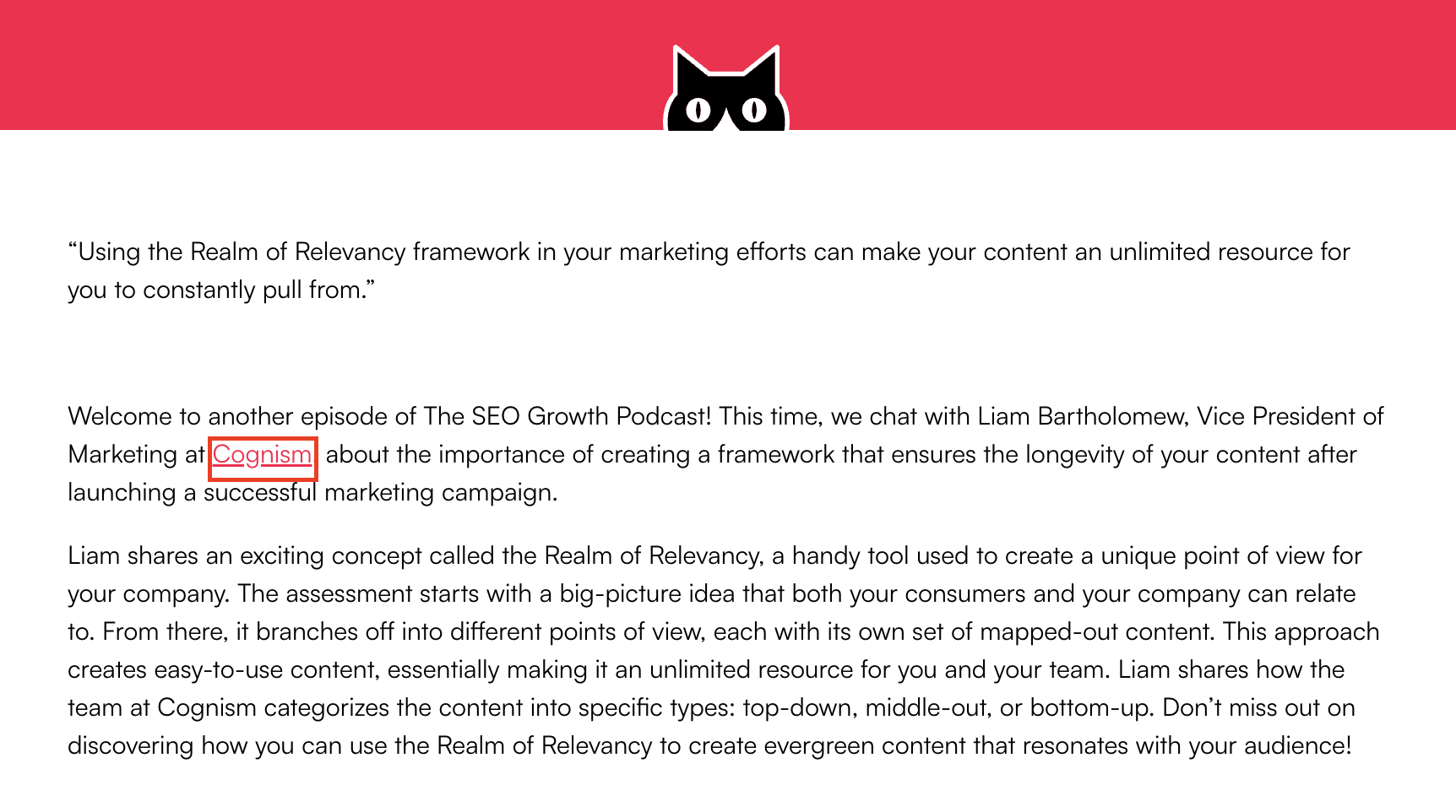
Here’s an example of a backlink from our very own podcast, The SEO Growth Podcast
Syed shares that he was able to secure more than 50 backlinks in a short period of time from this strategy alone.
8. Unlinked mentions
The Founder of LinkPitch, Aaron Anderson, says this tactic works by finding mentions of a brand where a link currently doesn’t exist, and asking for a link to be added in. These mentions can be the brand’s name (e.g. OpenAI), a specific product of theirs (e.g. ChatGPT), or the name of their CEO (e.g. Sam Altman).
He uses Ahrefs Content Explorer and Google Search Console to find unlinked mention opportunities. Content Explorer on Ahrefs allows him to highlight and export the data of sites that are currently not linking to yours. This tactic managed to score his client a link in the New York Times!
Jason Berkowitz, SEO Director at Break the Web says, “If the brand we’re working with has traditional Digital PR activities, often they’ll be referenced in an article, podcast, video, etc., and the brand name might be mentioned but doesn’t contain an <a href> link back to the client’s website.
Various tools can help you identify mentions of the brand without a link, and simple outreach to the brand asking for the link could be very effective for securing links from existing opportunities.
We’ve had about a 17% complete success rate with this tactic, on average, with a 5 email follow-up campaign. While that might seem low, it’s a pretty low-effort strategy that takes about 5 minutes to prospect a list of sites, and when the brands have an awesome PR agency getting them on some big sites, those tend to be harder.”
9. Join a Mastermind Group
Melanie Allen, owner of Partners in Fire, says that the most effective link building strategy she’s used has been joining a mastermind group.
“Yes, I had to pay to join, and it’s actually not a link building group. But it’s a group full of other bloggers in my niche who are all willing to help each other out and syndicate each other’s content. It’s been extremely beneficial for my blog growth.
Since joining the group, my domain authority has improved from 27 to 56.”
10. The passive favor strategy
If a company closely aligned with your brand reaches out to you for a request, return the favor by asking them for a link.
Harpreet Munjal, Founder & SEO Expert at LoudGrowth shares his strategy with us, “When a company that’s relevant to your website reaches out to you for a favor, ask for a link in exchange for the favor. You need to mention popular terms and products in your content to get more websites to reach out to you.It saves on effort and money, because you get links without the extra effort.”
Harpreet says that he has managed to get hundreds of links from reputable websites with a DR of 80+ with this strategy.
Why link building strategies are hard
Link building properly is 100% dependent on the relationships you can build.
It’s not that scalable.
For high-quality links, you need to build relationships with people who have good websites with actual readers. You can’t spam people asking them to publish on their page, or to link to you—you have to build relationships with them.
Frequently Asked Questions about link building strategies
Is link building hard?
Link building is not hard, but it requires a lot of time and commitment. In order to begin to build links and truly generate backlinks, you have to provide value—either to readers/journalists/content creators by providing useful, well-researched data, or to the host website, by providing something in exchange. You may need a full-service B2B SEO agency to help you launch your plan.
How do you run a link building strategy?
Link building is an art and a numbers game.
There are several ways to build links to your website. Whether it’s writing new content to publish on another website (guest blogging) or getting websites to insert your links on existing content (niche edits), there are endless ways to get links pointing to your website.
The challenge is finding ways that work.
